Must. Have. Chocolate!
 Friday, January 13, 2012 at 9:25AM |
Friday, January 13, 2012 at 9:25AM |  Taneasha
Taneasha 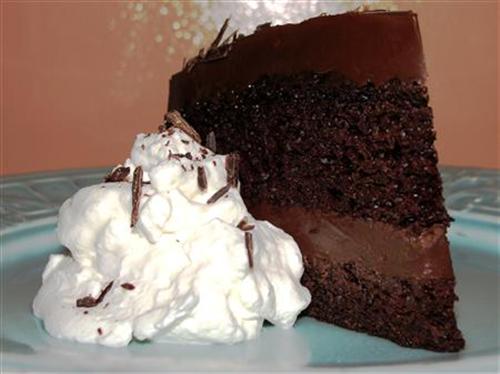
Chocolate. There really is no other food like it. I mean, when was the last time you were sitting in front of your computer and thought, “Man I could really go for a piece of broccoli right now!”? Now replace the word broccoli with the word chocolate. I bet you’ve thought that at least once in the last week, and probably within the last 48 hours. If not, you will after looking at the pictures in this post. As it happens, my chocolate cravings are usually very specific. Sometimes I want the snap and melt of a bar, sometimes the chew of a brownie, and occasionally, just a nice cold glass of chocolate milk. This time I wanted a piece of moist, rich chocolate cake with lots of fudgy ganache. That’s not really something you can get from the nearest grocery store. At least, not where I live, so that meant making my own. Fortunately, I had everything needed in my pantry, except the chocolate and cream for the ganache, which I had Hubby pick up on his way home from work.
Here’s what you need:
1 ¼ cups flour
1 cup sugar
½ cup cocoa powder
1 teaspoon baking soda
½ teaspoon baking powder
½ teaspoon salt
½ cup buttermilk
½ cup hot water
⅓ cup oil
1 egg
1 teaspoon vanilla
Cream and chocolate for ganache
The first you thing you need to do is prepare your pan. I used an 8 inch round pan that’s probably a good 2 inches deep. If, like my old pans, yours are not that deep, either use a larger pan, or make two thin cakes. In my world, you can’t make a cake without using parchment. Not if it needs to come out of the pan in one piece, anyway. Since I don’t have parchment rounds, I just trace around the bottom of my pan.
Then you can just cut it slightly smaller than what you drew, and it’ll fit perfectly. I like to use the If You Care brand of parchment products. Not only are they free of chemicals and whatever, but they work marvelously. Since this is a cake, which I’ll just pour in and it doesn’t have to really be spread around, I didn’t bother putting any butter down to keep the parchment in place. I just dropped it into the pan.
Once that’s done, go ahead and preheat your oven to 350°. (I remembered!) Put your sugar into a mixing bowl, sift in your dry ingredients, and then whisk them together.
In a separate bowl combine your egg, buttermilk, oil, and vanilla. A 4 cup measuring cup works great for this because you can measure, mix, and pour from one vessel.
As you probably noticed in the ingredients picture, I had a bottle of kefir. That’s just because the store I went to didn’t have buttermilk. To be honest, I’m not even sure what the difference is between cultured buttermilk and kefir. Kefir smells more like yogurt, but they’ve got to be very similar chemically, so you can always substitute one for the other. Whisk together your wet ingredients and pour them over the dry.
Mix until everything is incorporated, and then scrape everything down really well, including the bottom of the bowl. Mix the whole thing on medium speed for a good minute or so, and pour it into your waiting pan.
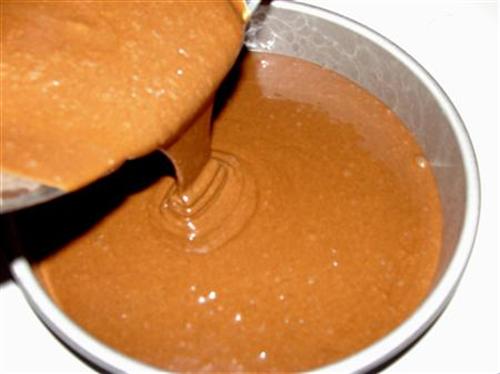
Into the preheated oven for 36-42 minutes, or until a toothpick inserted in the center comes out clean. A few crumbs on it are fine, just no batter. If yours cracks a little, like mine did, don’t worry. The cake will settle, and then we’ll be covering it with a nice thick layer of ganache.
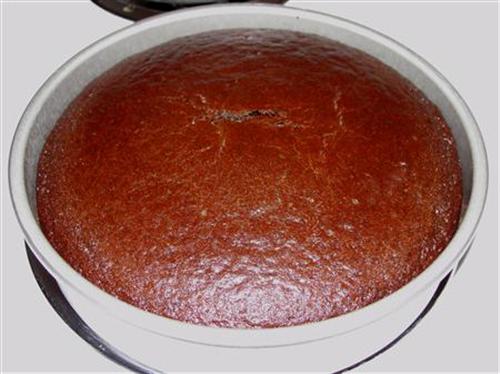
While the cake is hot, run a butter knife around the edge. Allow the cake to cool for 30 minutes in the pan, then remove it and allow it to finish cooling on a rack. Just leave the parchment in place for now. Once the cake has cooled completely, put it back into its pan and into the fridge. Getting it nice and cold will make it much easier to cut into layers. Since I had to wait for Hubby to get home with my ganache ingredients, I actually just covered the cake and refrigerated it overnight.
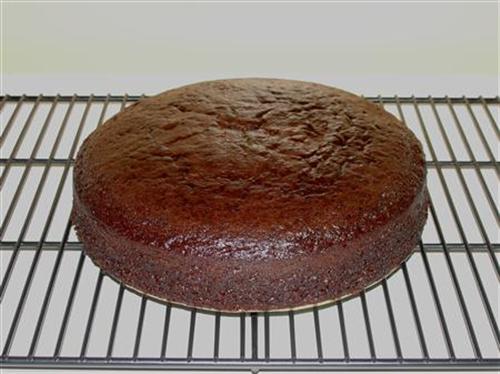
Speaking of ganache, let’s make some now. For ganache I’ll be using on a cake, I prefer to use milk chocolate, but you can use whichever variety you like. Since Hubby had to stop at the store, I had him go to Trader Joe’s and get me one of their awesome pound plus chocolate bars, but you can definitely use chocolate chips for this if you want. You’ll need about 3 cups, or just over a pound of finely chopped chocolate or chocolate chips in a glass bowl with plenty of extra room.
Heat 1 pint of heavy cream over medium heat until it just barely reaches a simmer. You’ll see little bubbles forming around the edges.
Pour the hot cream over the chocolate, and leave it for 2 minutes.
After two minutes, grab a whisk and slowly start stirring. At first it’ll just look like a mess.
But it will eventually come together and become perfectly smooth and creamy. It might seem a bit thin while it’s hot, but it’ll firm up as it cools.
Pull your cold cake out of the fridge and peel the parchment off the bottom.
What did bakers ever do before parchment? Place your cake on a flat surface that’s elevated. I just flipped the cake pan over. Using a large knife, cut your cake in half. I know it’s easier said than done, but just try to keep your knife as level as you can and keep turning the cake. If you cut it a bit higher than I did, it’ll look more uniform when it’s finished.
When your ganache is fudgy, but still spreadable, plop about a third of it onto the bottom half of your cake. Spread it around, leaving about a half inch border. It’ll spread a bit more when you put the top on, and whatever space is left, will be filled when you cover the sides.
Place the top layer on the ganache and press it down slightly.
Glop the rest of your ganache in a pile on top.
Spread it around until it starts to hang over the sides.
Then just start to work that around the sides. An offset spatula makes this job a lot easier. I’m no cake decorator, so I basically just keep spreading the ganache around until everything is covered fairly evenly. You might have noticed that I placed my cake on strips of parchment… this is why.
You can pull them out, leaving a clean surface around the base of your cake. Ganache tends to stick to the parchment a bit, so just sort of poke your spatula along the edge to help loosen it from the parchment, then pull the strip out slowly. Personally, I’m of the opinion that chocolate cake should have as few adornments as possible. I opted for just sprinkling the edge with a little shaved chocolate, which I made by just running a vegetable peeler over a bar of chocolate. Never will you see me use sprinkles. They are evil, wretched, horrible things that taste much more like plastic than food. But do as you like.
Really you don’t need more than just a plate and a fork, but I added a dollop of fresh whipped cream to my plate. You can’t really go wrong with whipped cream, can you?
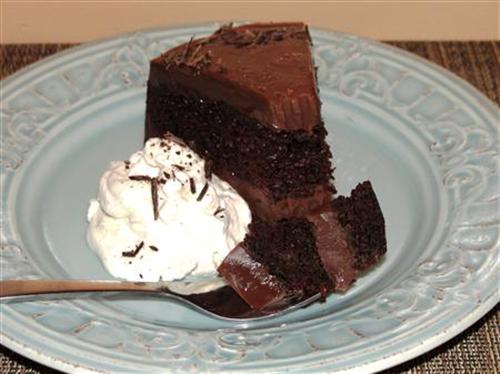
This cake is extremely rich. You’ll probably want to cut smaller slices than I did. I ran out of steam before I could finish it.
What’s your favorite chocolate indulgence?
 chocolaty goodness,
chocolaty goodness,  more chocolate,
more chocolate,  sprinkles are evil in
sprinkles are evil in  Taneasha,
Taneasha,  baked goods,
baked goods,  dessert
dessert 
